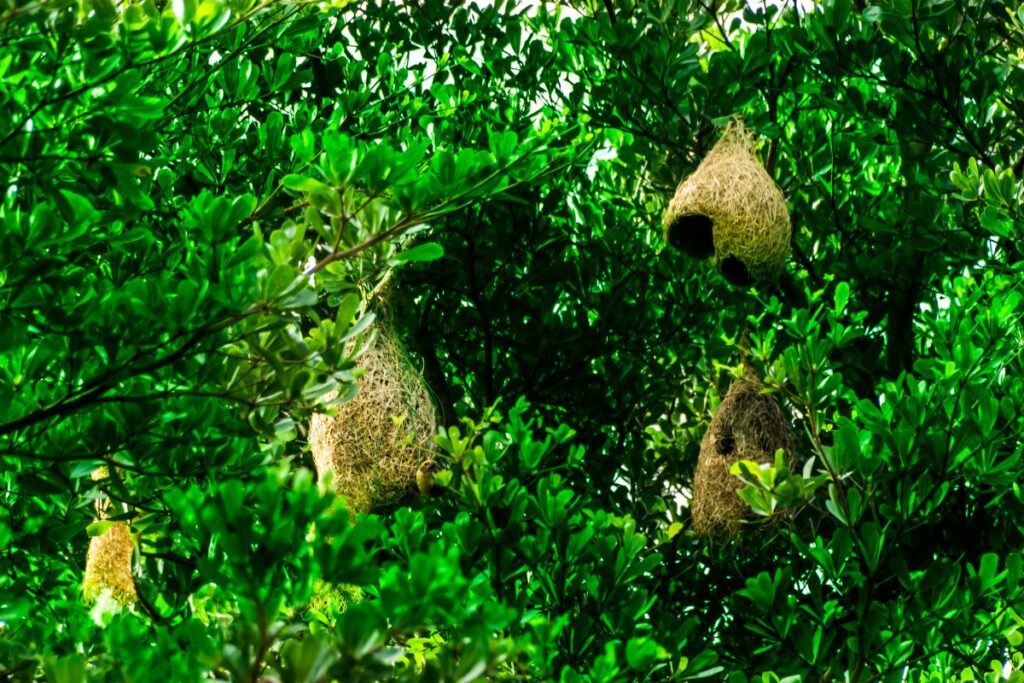As an Amazon Associate, we earn from qualifying purchases with no additional costs for you.
Birds are remarkable animals that show adaptations to their environment. They also construct nests in which they lay eggs, incubate, and then rear the young that hatch. You may be curious as to how a bird can remember where its nest is, especially when some birds build nests in dense forests, and the nests are also often well hidden.
Birds remember their nest location through a combination of visual cues, landmarks, and keen spatial awareness. Their remarkable memory helps them navigate by recognizing distinct features in their surroundings. Landmarks can include trees, bushes, areas of water and grass, and man-made structures.
Birds rely on an innate sense of direction, honed through experience, ensuring a successful return to their home base. They can also orient themselves using the Earth’s magnetic field. Read further to learn more about how birds can find their nests and how else they are able to navigate successfully.
TIP: If you want to check out the best pair of binoculars for bird watching, we recommend a pair of waterproof and fog-proof 8 x 42 binoculars like the Celestron – Outland X 8×42 Binoculars (Amazon link).
How Do Birds Remember Where Their Nest Is?

Birds use visual cues, including features of the landscape, to find where their nest is. Trees, bushes, areas of grass, and water features may all be recognized by birds so that they can find their way back to where they built their nest.
Some birds nest on the ground, making it amazing that they can find their nest in an expanse of grassland. Watch this video to find out which birds nest on the ground:
Birds, in general, also use the Earth’s magnetic field to navigate. This is likely more important during migration when birds travel long distances. The birds can sense the magnetic field based on special molecules in their eyes.
This video explains how migratory birds use earth’s magnetic field as an aid to navigation:
These magnetosensory protein molecules are called cryptochromes. These cryptochromes react in different ways to show a bird’s direction. It is thought that the molecules slightly alter the vision of the bird. The bird sees different shading according to where it is located relative to the magnetic north.
Watch this video to learn how birds navigate earth’s magnetic field:
Landmarks That Birds Use
The types of features that birds use in the landscape include shorelines, bodies of water, mountain ranges, vegetation, and man-made structures. Birds use different landmarks depending on where they are flying. A bird in your garden may use various types of plants and trees to find where their nest is.
It makes sense that birds use visual cues to help navigate since their vision is superior to humans. Birds can see more colors than humans and can even see parts of the UV color spectrum.
This means birds can detect fine changes in coloring that we cannot see, so a monotonous grassland is not as uniformly colored as we may perceive. This could explain why it is easier for birds to find their nests, even in a grassland.
Besides color, landscape features vary in size, shape, and texture. Birds likely use several landscape characteristics to remember where their nests are.
This video explains what bird’s can see, and what you cant!
Nest Site Choice
The birds can assess the best place to build a nest. A nest needs to be hidden from any potential predators and provide a safe place to incubate eggs and raise chicks.
Where a bird decides to build a nest varies by species. Many passerine bird species build nests in trees and shrubs, but some use cliffs or man-made structures.
Species may build under the eaves of a house or even in a crack in a wall. In some countries, nesting platforms are constructed for certain raptors. This is the case for the Ospreys in the United States.
Some birds, such as Sociable Weavers and Village Weavers, nest in big colonies. The Sociable Weavers build very large nests with multiple chambers. The birds collectively build the nest.
Watch how Sociable Weavers build their nests in this video:
The Village Weavers nest colonially but build their own nests separate from others in the tree. The birds strip leaves off the branches to make it easier to spot a snake, which may prey on their chicks. Village Weaver nests are, thus, quite easy to see. The males display on the edge of the nest to attract a female.
How Do Homing Pigeons Find Their Way Home And Back To Their Nests?
Homing pigeons seem to find their way home easily, and scientists have been intrigued for many years about how these birds can return home. It is thought that the pigeons can use visual cues; many landmarks are used by the birds to help them find their way.
The pigeons are also believed to use the magnetic field of the Earth when flying so as not to get lost. The birds have magnetoreception, specifically, the cytochrome proteins that have been discovered in the bird eyes that help with navigation.
Researchers have found that genetic variability in these proteins impacts how well homing pigeons can find their way back home.
TIP: Check out my recommended products if you are looking for the best and trusted equipment for birdwatching in the wild or on your backyard (Amazon link):
- Celestron Outland X 8×42 Binoculars
- Celestron Ultima 80 Angled Spotting Scope
- National Audubon Society Birds of North America Book
- Design Free-standing Bird Bath
- Smart Bird Feeder with Camera
- Cedar Bird House for Outside
How Migrating Birds Navigate
Birds can navigate using landmarks and cues such as the position of the sun and also the magnetic field of the Earth. Some birds migrate at night and may also use the position of the stars to direct them to the correct route.
There are certain bird species that use smell to help them navigate. This was discovered during research on Scopoli’s Shearwaters, birds that migrate over the ocean.
While we don’t think of birds relying on smell to find their way, it makes sense that some oceanic species use smell because the open ocean does not have visual landmarks to help birds that are migrating.
Albatrosses are big oceanic birds that fly vast distances yet always return to their nest. They also return to the same nest each year. These birds are believed to mainly navigate using the Earth’s magnetic field.
They have also been shown to fly in different directions depending on the weather due to arrive 24 hours later. It is thought that the birds can sense changes in barometric pressure that precede weather changes.
TOP TIP: Did you know that there are 5 distinctive types of bird wings? Read this article to find out more! How many birds are in the world? Find out the answer to this and many more aviary facts here!
Mountain Ranges And Migrating Raptors
Vultures and other raptors often migrate by following mountain ranges. There is a good reason for this. The updrafts and thermals created by this type of landscape are beneficial for the flight of bigger birds. Raptors frequently use these updrafts to glide, meaning they need to expend less energy to stay aloft.
When thermals and updrafts are absent, these birds have to use a lot of energy to flap their wings to stay airborne. It makes sense that migration is easier and more energetically efficient for these birds when they use thermals and updrafts.
Bird watchers often visit mountainous areas that are known for being good spots to see thousands of migrating hawks.
Many of the best hawk-watching spots in North America are, in fact, found along mountain ranges, where thousands of hawks and other birds of prey can be spotted in the sky during migration.
Hawk Mountain Sanctuary, Pennsylvania, is one place where you can see many migrating Broad-winged Hawks, Turkey Vultures, and Swainson’s Hawks in October during Fall migration.
TIP: Knowing how to spot the birds in your yard is key to enjoying visits from your winged friends as much as possible! The best sources are trusted books, I recommend using the following (Amazon links):
– National Geographic Field Guide to the Birds of North America
– National Audubon Society Birds of North America
Conclusion
Birds can remember where their nest is by using various landmarks, including vegetation and bodies of water. Mountains, open areas, and even man-made structures can be used by birds to find their way home.
In general, birds can navigate using landmarks, the position of celestial objects, and the magnetic field of the Earth. The eyes of birds contain a protein that helps determine the position of magnetic north and thus helps them to know where they are.

